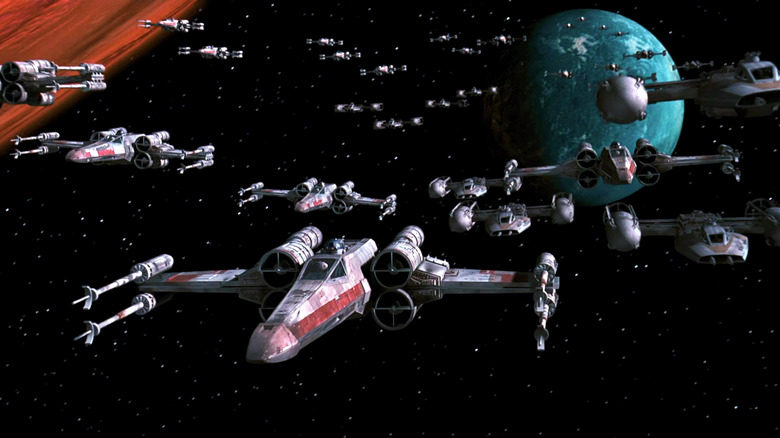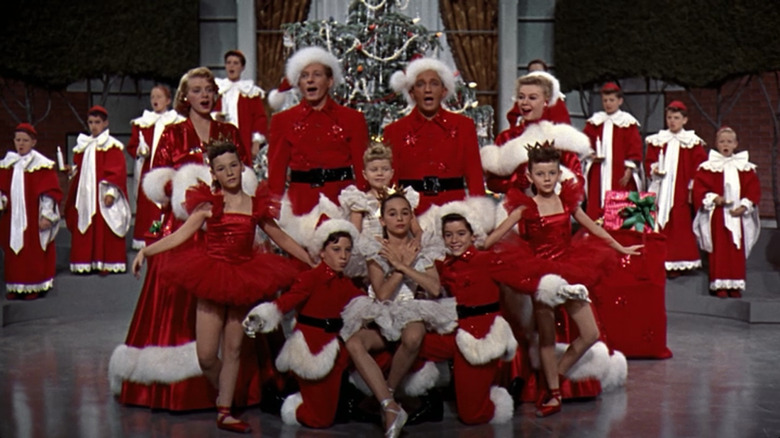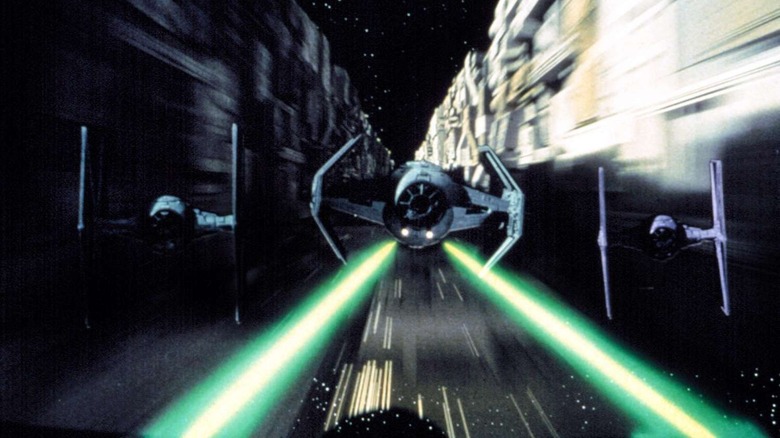How George Lucas Revived 1950's Technology To Make Star Wars
For so many reasons, George Lucas' 1977 "Star Wars" is a revolutionary film. Like any game-changer, some of the ways in which "Star Wars" re-shaped the cinematic landscape couldn't have been predicted; its ushering in a huge wave of big budget sci-fi/fantasy films, its one-two punch with "Jaws" establishing the summer blockbuster, its use of Joseph Campbell-inspired myth making shaping the way so many screenplays would be written for the next few decades, and so on.
However, some of the innovations created by "Star Wars" were very visible while it was being made, none more so than by Lucas himself. In addition to gathering together a cadre of visual-effects pioneers and wizards who could make his vision a reality on screen (a coterie later dubbed Industrial Light & Magic), Lucas faced the problem of making sure their work could be seen in its best light, literally. As Paul Hirsch, one of the editors of "Star Wars" along with Marcia Lucas and Richard Chew, recalled in his memoir "A Long Time Ago in a Cutting Room Far, Far Away," the issue Lucas was facing with regard to the visual effects was one of degeneration. Up to that point in filmmaking, a good number of visual effects were done optically, and those were achieved, as Hirsch recalled, "by rephotographing original negative, either with mattes or through filters and lenses, with an aerial head, which permitted the image to be enlarged or reduced, tilted or reversed, or other elements to be superimposed, and various other tricks."
The end result was that the image suffered from a loss of quality, much like making a copy of a copy would do. In order to get around this, Lucas turned to a photographic system first established in the 1950s: VistaVision.
A brief history of VistaVision
The story of the VistaVision process is one that is born out of the growing popularity of television in the '50s, something which caused a recession in the film industry in the early part of the decade. As a response to television's threat, many attempts were made to revamp theatrical exhibition in order to provide a moviegoing experience that television couldn't hope to match. The first and most impressive of these new processes was 1952's Cinerama: taking to heart the axiom that more is more, Cinerama expanded the then-standard movie screen dimensions (which more or less resembled a square) into a huge, curved, widescreen format with seven-channel sound as opposed to the typical one-speaker mono. However, Cinerama gained all this through a costly, prohibitive process: not only did it require special camera systems to shoot, but a special projector system to exhibit, consisting of three separate strips of 35mm film run side-by-side.
Following the successful public response to Cinerama (but understanding that such an idea needed to be made more cost-effectively), Twentieth Century-Fox developed CinemaScope in 1953, which more or less established what we now know as the anamorphic widescreen format. Not to be outdone, Paramount Pictures began work on their own widescreen format, eventually dubbed (you guessed it) VistaVision. Premiering with Michael Curtiz' "White Christmas" in 1954, VistaVision's biggest innovation was its clarity of image, garnered thanks to shooting film horizontally on a large eight perforation frame, one image exposure per frame.
Although the VistaVision process allowed for larger, sharper images without requiring special projection equipment for exhibition, the camera systems for filming were specialized, which required a good deal of money, and the process became obsolete once new film stocks (including 70mm) were developed and put into standard use. Although a hugely important step in cinema's evolution, VistaVision's existence was short lived; the last movie to be shot in the process (in America, anyway) was 1961's "One-Eyed Jacks."
VistaVision to the rescue
That wasn't the end of VistaVision's story, however. While making "Star Wars," Lucas, Richard Edlund, John Dykstra and the rest of the film's crew realized that they could utilize the VistaVision process to shoot the movie's visual effects with so that they would have no degenerative issues. As Hirsch described in his own words:
"In VistaVision, each frame was eight perfs (perforations) wide, and the frames were side by side. In standard 35mm film, the frames are stacked one above the other and are only four perfs high. The result is that each frame of a VistaVision negative is much sharper. When the optical process we were using degraded the image, the resulting quality, theoretically, would be very close to the look of standard four-perf original."
The plan to revive an obsolete process was not without its hurdles, however — Lucas soon discovered that there were no remaining VistaVision compatible optical printers, which meant that ILM had to build something in order to accommodate the eight-perf format. As such, Dykstra concocted a new camera system in order to shoot the effects material with VistaVision, resulting in the self-titled Dykstraflex camera. The first digital motion control camera, the Dykstraflex allowed for spaceship models and the like to be shot in VistaVision with programmable camera movements, meaning that all the elements necessary for a shot could be filmed with the digital system accounting for the camera's movements, allowing those motions to be repeated exactly each time.
Although the move away from shooting on film within the industry has essentially rendered VistaVision obsolete (again), it's hung on in a few instances, most notably being used in the making of several of Christopher Nolan's films (such as "Interstellar") and even was utilized as recently as 2022's "Jurassic World Dominion." It just goes to show you: never count out old-fashioned things completely! They can still be viable.


